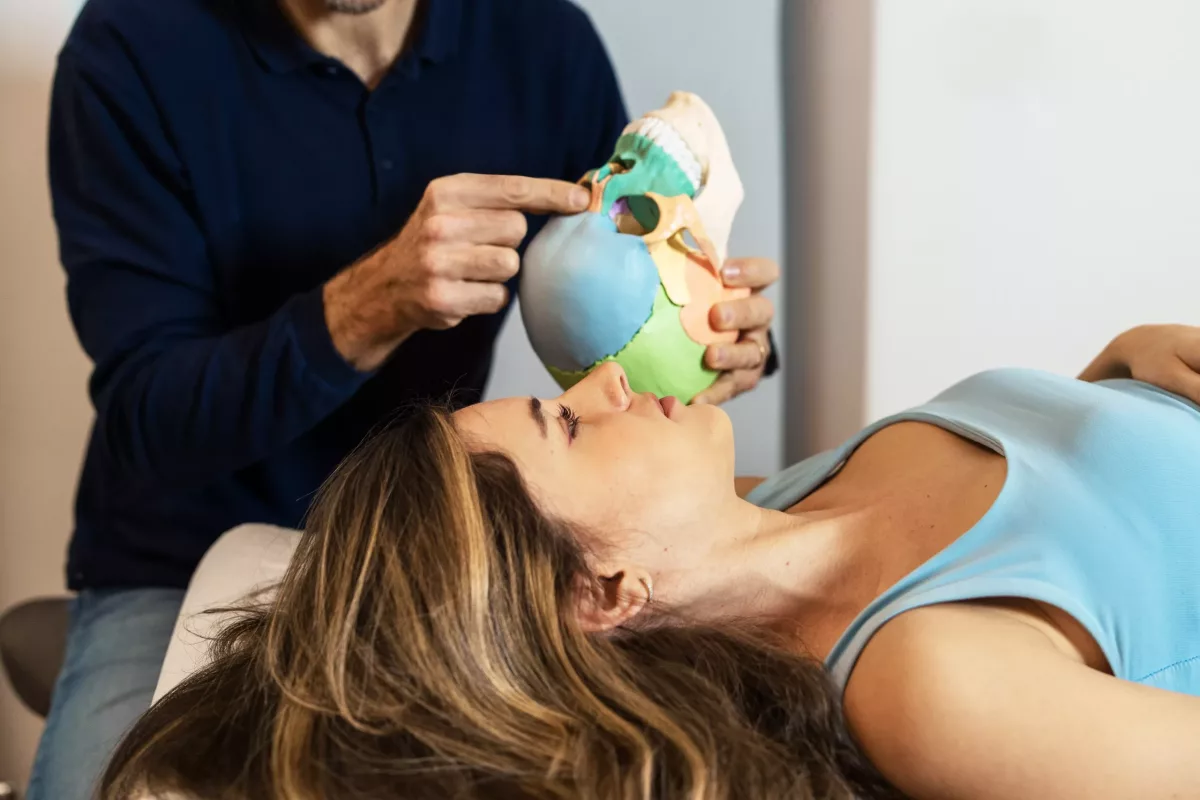A health condition that causes pain and tenderness in the jaw joints and surrounding ligaments and muscles is called temporomandibular joint dysfunction (TMD). The most common causes include jaw trauma, arthritis, daily wear and tear, and teeth grinding. Treatment is usually different among people with TMD because it depends on the exact cause and the severity of the condition. However, doctors often prescribe medicines, physical therapy, or jaw surgery (in severe cases).
People who develop this condition may experience jaw pain, headaches, difficulty opening and closing the mouth, and other symptoms. Generally, these disorders are called temporomandibular joint disorders (TMJ), but TMD refers to temporomandibular joint dysfunction. In some cases, this TMD is called temporomandibular joint disorder.
Normally, people have two TMJs (temporomandibular joints) that are located on each side of the face, in front of the ears. These TMJs connect the lower jawbone to the skull and also help with movements, including speaking and chewing.
In addition, approximately 10% of adults people develop a form of TMJ disorder. It is mostly diagnosed in women, especially between the ages of 20 and 40.
Types of TMD
Physicians classified TMDs into 3 categories. For example:
- Disorders of the jaw joints
- Headaches that are caused by TMD
- Disorders of the chewing muscles
Symptoms
The symptoms of TMD usually appear differently among people. It depends on the type, location, and severity of the injury, existing health problems, age, and other factors. Check below some examples:
- Jaw, facial, shoulder, or neck pain
- Difficulty closing and opening the mouth
- Migraines
- Toothaches
- Earaches
- Tinnitus (ringing in the ears)
- Malocclusion (changes in the way teeth fit together)
- Jaw popping, clicking, or stiffness
If you experience any of the previous symptoms or others that cause concerns, immediately see a doctor.
Causes
There are multiple causes of TMD. Sometimes, it may happen due to a combination of factors. Check below some examples:
- Jaw injuries (such as a broken or dislocated jaw)
- Arthritis in the jaw joint
- Stress
- Bruxism (teeth clenching or grinding)
Furthermore, there are some things that may worsen the symptoms of TMJ dysfunction. For example:
- Sleeping on the stomach
- Big bites of food
- Chewing ice, pens, pencils, or other items
- Poor posture may put extra pressure on the neck, shoulder, and facial muscles
- Using teeth as a tool
Risk Factors
Some factors may significantly elevate your risk of developing TMJ disorders. These include:
- Gender – Females are more prone to develop these disorders than males.
- Age – These conditions often occur between the ages of 20 and 40.
- Genetics – Sometimes, people are more likely to develop these disorders due to a hereditary component.
- Other health conditions – These include sleeping disorders (including snoring and sleep apnea), arthritis, and others.
- Stress and anxiety
- Dental problems (such as misaligned teeth or bite problems)
- Lifestyle factors – For example, smoking, misuse of alcoholic beverages, and others.
What Are The Potential Complications of Temporomandibular Joint Disorders?
Those who develop this condition may also experience some complications, especially if they ignore the symptoms and do not get treatment. These include:
- Chronic pain
- Dental problems (such as misalignment of the jaw that often leads to tooth damage or even loss)
- Limit jaw function
- Sleep problems (including sleep apnea, which often causes poor sleep quality and persistent fatigue)
- Psychological distress (such as anxiety, depression, and others)
You can talk with your healthcare professional about ways to reduce the risk or prevent complications of these disorders.
How to Prevent Temporomandibular Joint Disorders?
It is not always possible to prevent these disorders because there are some risk factors that cannot be avoided. However, the following tips may help reduce the risk of developing TMD. For example:
- Wear a mouth guard at night, especially if you grind or clench your teeth or when playing contact sports
- Practice good posture
- Manage stress (you can consider meditation, mindfulness, and other stress reduction techniques)
Diagnosis
Physicians usually diagnose TMJ disorders during a dental checkup or physical examination. They often check for the range of motion when you close or open the mouth, areas that cause discomfort, and other symptoms that may indicate these disorders. When it is not clear, doctors may perform some tests to identify the exact cause of the condition and rule out others that cause similar symptoms. Check below some tests often involved in temporomandibular joint disorders:
- Dental X-rays
- CT (computed tomography) scans
- MRI (magnetic resonance imaging) scans
- TMJ arthroscopy (sometimes, this procedure is used as treatment)
Treatment
The treatment is often different for people with TMJ disorders because it depends on several factors. These include the type and severity of the condition, age, overall health, and preferences. Usually, physicians recommend nonsurgical options first. However, if you do not notice any improvements, doctors may recommend other treatments. Check below some treatments commonly prescribed by doctors to treat TMJ disorders:
Medicines
Check below some over-the-counter (OTC) and prescription medicines used to relieve symptoms of these disorders:
- Muscle relaxers (may help lessen clenching or grinding of the teeth)
- Antidepressants (these medicines help reduce pain)
- Nonsteroidal anti-inflammatory drugs (NSAIDs), including Naproxen sodium or Ibuprofen
- Painkillers (such as Acetaminophen)
However, never take any of the previous medicines without a doctor’s approval. Otherwise, any of the previous medicines may worsen the symptoms.
Nonsurgical TMJ Treatments
- Mouth guards – These oral splints or mouth guards may help reduce the effects of grinding and clenching. While there are multiple OTC options, it is recommended to get a custom mouth guard from a dentist.
- Physical therapy – During this treatment, therapists help patients learn exercises to stretch the jaw and strengthen the muscles near the jaw joints.
- Trigger point injections – This treatment involves injections with Corticosteroids or Botulinum toxin into painful knots in the jaw. It often helps lessen inflammation and pain.
- Ultrasound therapy – This treatment option involves sound waves that help relax the muscles around the jaw joints and improve blood flow.
- Transcutaneous electrical nerve stimulation (TENS) – This is a specific treatment option that delivers small electrical currents to the jaw muscles to relax them.
- Behavioral changes – For example, posture improvements.
Surgical TMJ Treatments
The following treatments are often recommended by doctors when medicines and nonsurgical options do not work. For example:
- Arthrocentesis – Healthcare professionals use a needle to remove fluid from the joint, which often helps relieve the symptoms.
- TMJ arthroscopy – This procedure involves a small incision (cut) in front of the ear and then inserting a small and flexible tube with a lighted camera on the end. Therefore, they insert surgical tools to remove scar tissue and put the disk in the joint in a proper position.
- Open-joint surgery – During this treatment, surgeons will make a long cut (incision) that allows access to the jaw joint directly.
Frequently Asked Questions
How long does TMJ dysfunction last?
While some people get rid of the condition on their own, others may experience symptoms for up to 14 days. In severe cases, the symptoms last for months or even years.
Can TMJ disorder be cured?
Yes, there are a lot of treatments that can cure this disorder. If you think you have TMJ disorder, do not hesitate to see a physician.
What are the warning signs of a TMJ disorder?
These include:
- Headaches
- Facial or neck pain
- Tenderness or pain in the jaw
- Difficulty chewing
If any of the previous symptoms occur, immediately contact your doctor. If you have additional questions, ask your healthcare provider.




